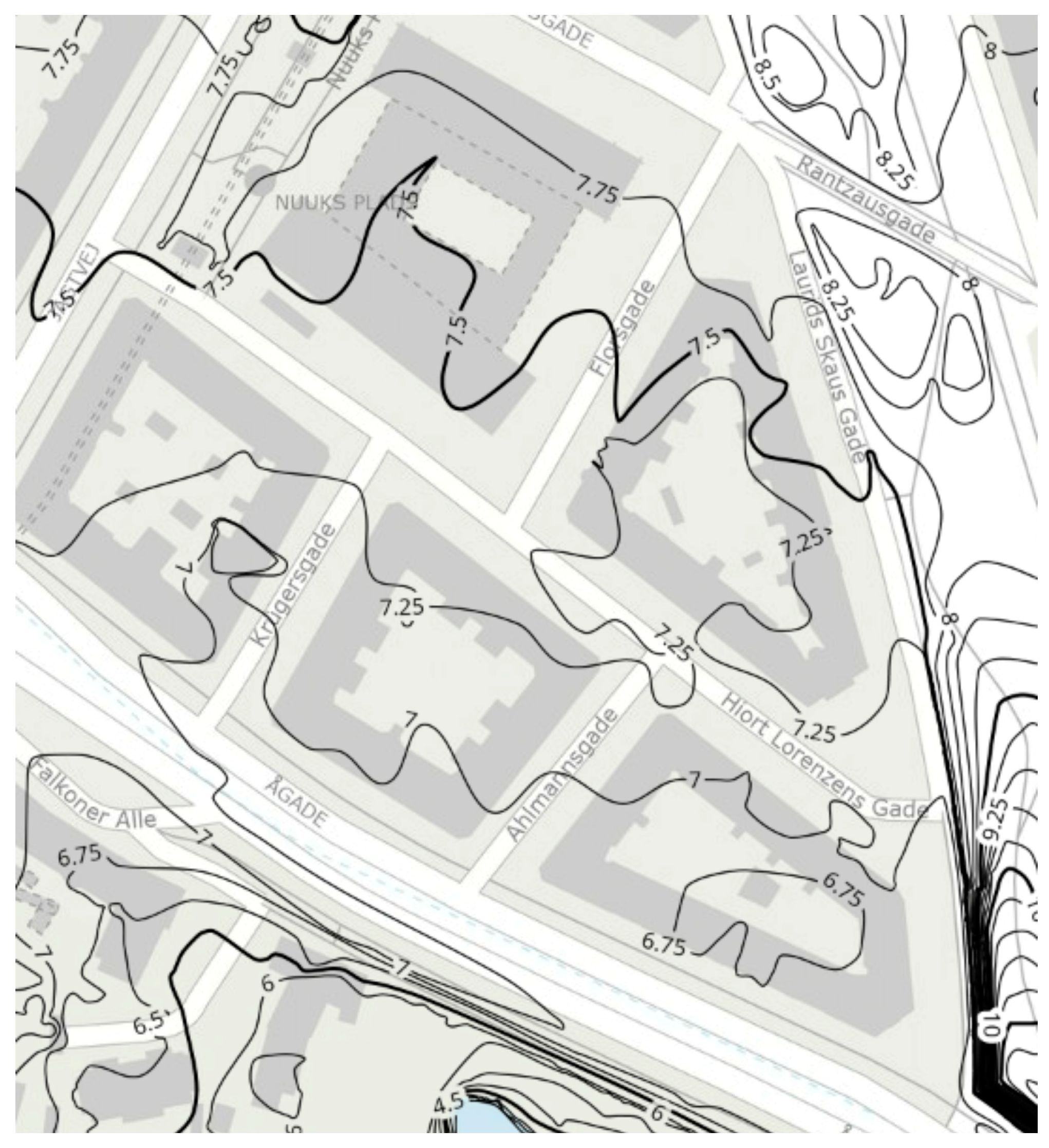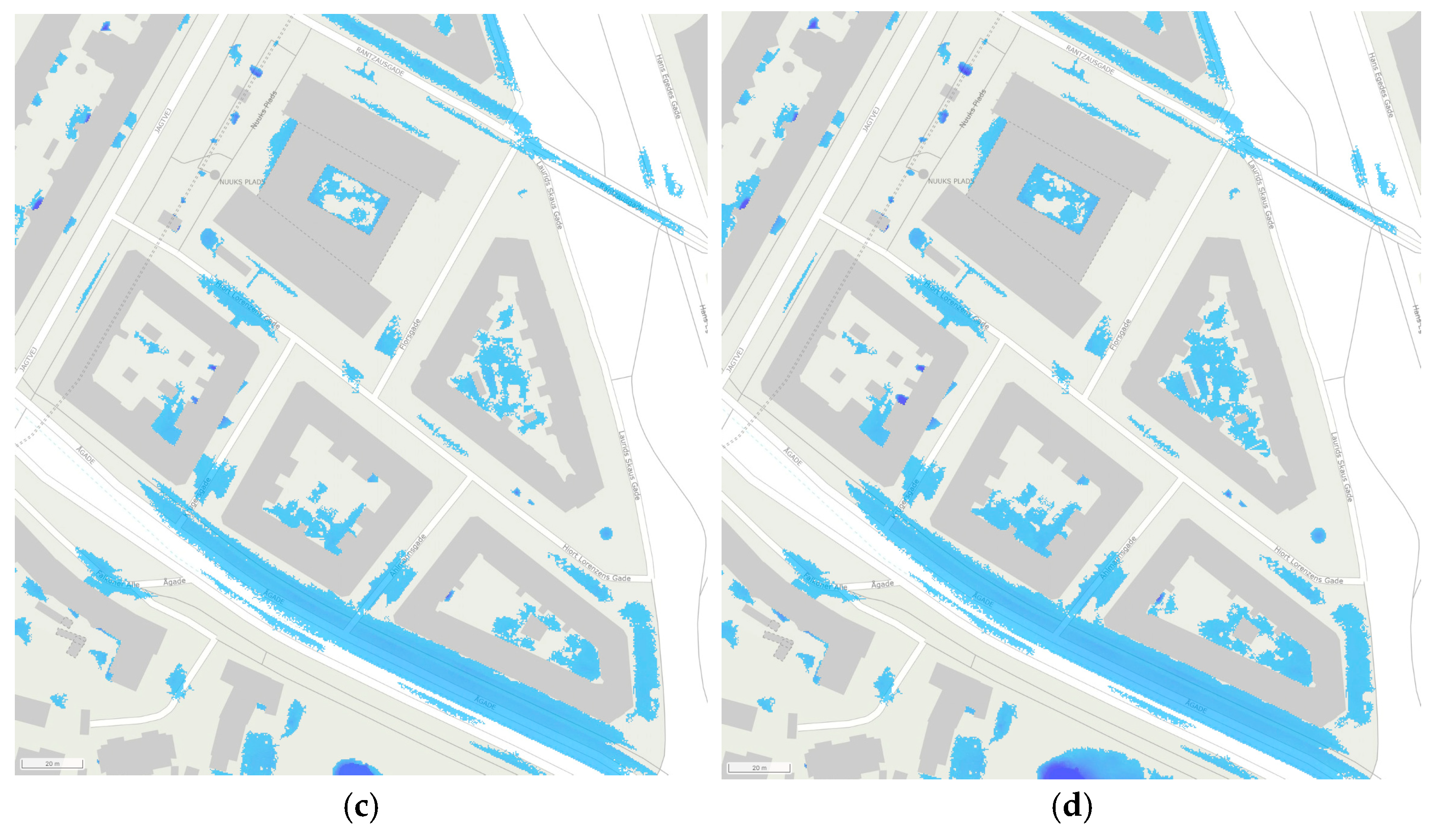Nature-Based Solutions Applied in Urban Drainage Systems: A Case Study Using GIS-Based Hydrological Modeling †
Abstract
1. Introduction
2. Material and Methods
2.1. Streamlined Simulation Framework
2.2. Hydrologic Modeling
2.3. Description of the Case Study
2.4. Description of the NbS Scenarios
3. Results and Discussion
4. Conclusions
Funding
Institutional Review Board Statement
Informed Consent Statement
Data Availability Statement
Conflicts of Interest
References
- Beceiro, P.; Brito, R.S.; Galvão, A. Assessment of the contribution of Nature-Based Solutions (NBS) to urban resilience: Application to the case study of Porto. Ecol. Eng. 2022, 175, 106489. [Google Scholar] [CrossRef]
- Biswal, B.K.; Bolan, N.; Zhu, Y.G.; Balasubramanian, R. Nature-based Systems (NbS) for mitigation of stormwater and air pollution in urban areas: A review. Resour. Conserv. Recycl. 2022, 186, 106578. [Google Scholar] [CrossRef]
- Sowińska-Świerkosz, B.; García, J. What are Nature-based solutions (NBS)? Setting core ideas for concept clarification. Nat.-Based Solut. 2022, 2, 100009. [Google Scholar] [CrossRef]
- Lafortezza, R.; Chen, J.; Van Den Bosch, C.K.; Randrup, T.B. Nature-based solutions for resilient landscapes and cities. Environ. Res. 2018, 165, 431–441. [Google Scholar] [CrossRef] [PubMed]
- Maes, J.; Jacobs, S. Nature-based solutions for Europe’s sustainable development. Conserv. Lett. 2017, 10, 121–124. [Google Scholar] [CrossRef]
- Naumann, S.; Burgos Cuevas, N.; Davies, C.; Bradley, S.; Mahmoud, I.H.; Arlati, A. Harnessing the Power of Collaboration for Nature-Based Solutions: New Ideas and Insights for Local Decision-Makers. Publications Office of the European Union, 2023. Available online: https://data.europa.eu/doi/10.2777/954370 (accessed on 13 November 2024).
- Coelho, L.M.G. Assessing the effect of local characteristics on environmental impacts of Constructed Wetlands by regionalized life cycle assessment. Ecol. Eng. 2024, 209, 107423. [Google Scholar] [CrossRef]
- Mihalakakou, G.; Souliotis, M.; Papadaki, M.; Menounou, P.; Dimopoulos, P.; Kolokotsa, D.; Paravantis, J.A.; Tsangrassoulis, A.; Panaras, G.; Giannakopoulos, E.; et al. Green roofs as a nature-based solution for improving urban sustainability: Progress and perspectives. Renew. Sustain. Energy Rev. 2023, 180, 113306. [Google Scholar] [CrossRef]
- Greksa, A.; Blagojević, B.; Grabić, J. Nature-based solutions in Serbia: Implementation of rain gardens in the suburban community Kać. Environ. Process. 2023, 10, 41. [Google Scholar] [CrossRef]
- Poje, M.; Židovec, V.; Prebeg, T.; Kušen, M. Does the Use of Perennials in Flower Beds Necessarily Imply Sustainability? Plants 2023, 12, 4113. [Google Scholar] [CrossRef]
- Radić, M.; Brković Dodig, M.; Auer, T. Green Facades and Living Walls—A Review Establishing the Classification of Construction Types and Mapping the Benefits. Sustainability 2019, 11, 4579. [Google Scholar] [CrossRef]
- International Union for Conservation of Nature and Natural Resources—IUCN. Guidance for Using the IUCN Global Standard for Nature-Based Solutions. A User-Friendly Framework for the Verification, Design and Scaling up of Nature-Based Solutions, 1st ed.; IUCN: Gland, Switzerland, 2020; ISBN 978-2-8317-2061-6. [Google Scholar] [CrossRef]
- Brauman, K.A.; Bremer, L.L.; Hamel, P.; Ochoa-Tocachi, B.F.; Roman-Dañobeytia, F.; Bonnesoeur, V.; Arapa, E.; Gammie, G. Producing valuable information from hydrologic models of nature-based solutions for water. Integr. Environ. Assess. Manag. 2022, 18, 135–147. [Google Scholar] [CrossRef]
- Kumar, P.; Debele, S.E.; Sahani, J.; Rawat, N.; Marti-Cardona, B.; Alfieri, S.M.; Basu, B.; Basu, A.S.; Bowyer, P.; Charizopoulos, N.; et al. Nature-based solutions efficiency evaluation against natural hazards: Modeling methods, advantages, and limitations. Sci. Total Environ. 2021, 784, 147058. [Google Scholar] [CrossRef] [PubMed]
- Guido, B.I.; Popescu, I.; Samadi, V.; Bhattacharya, B. An integrated modelling approach to evaluate the impacts of nature-based solutions of flood mitigation across a small watershed in the southeast United States. Nat. Hazards Earth Syst. Sci. Discuss. 2023, 2023, 2663–2681. [Google Scholar] [CrossRef]
- Santos, K.A.; Coelho, L.M.G.; Santos, H.A. Proposal of a new approach to perform advanced flow modeling for subsurface flow treatment wetlands. Water Sci. Technol. 2023, 88, 1155–1177. [Google Scholar] [CrossRef]
- Scalgo. Available online: https://scalgo.com/en-US/ (accessed on 13 November 2024).
- Aabling, T.; Gabriel, S.; Arnbjerg-Nielsen, K. Dimensionering af LAR-anlæg. Spildevandskomiteens Skrifter (2023). 2023. Available online: https://spildevandskomiteen.dk/dimensionering-lar/ (accessed on 13 November 2024).
- Scalgo: Soil Types—Infiltration Properties. Available online: https://scalgo.com/en-US/scalgo-live-documentation/soil-vegetation-atmosphere-properties/soil/properties (accessed on 13 November 2024).
- Frederiksberg Kommune. Available online: https://www.frederiksberg.dk/kommunen/forvaltning-og-fakta-om-kommunen/fakta-om-kommunen#befolkningsprognose-83 (accessed on 13 November 2024).
- Vejen, F. Tropisk Styrtregn over København d. 2. juli 2011. Alle Danske Monsterregns Moder. Vejret-Tidsskr. Vejr Og Klima 2011, 33. Available online: https://www.yumpu.com/da/document/view/18472388/-tidsskrift-for-vejr-og-klima (accessed on 13 November 2024).
- Lindholm, O.; Buhler, L.; Bjerkholt, J. Hva hvis monsterregnet fra København 2. juli 2011 hadde falt i Norge. What If the Monster Rain from Copenhagen on. 2011, Volume 2. Available online: https://vannforeningen.no/wp-content/uploads/2015/06/2013_882444.pdf (accessed on 13 November 2024).
- Skybrudssikring af København—Skybrudsopland: Østerbro. Available online: https://kk.sites.itera.dk/apps/kk_pub2/pdf/1189_i4uujk7E4M.pdf (accessed on 13 November 2024).
- Dansk Meteorologisk Institut—DMI. July 2—One Year Since the Copenhagen Cloudburst. 2024. Available online: https://www.dmi.dk/nyheder/2012/2-juli-et-aar-siden-det-koebenhavnske-skybrud/ (accessed on 13 November 2024).
- Code DS 432; Code of Practice for Sanitary Drainage. Dansk Standard: Copenhagen, Denmark, 2009; 87p.
- Spildevandskomiteen. Skrift 27: Funktionspraksis for Afløbssystemer Under Regn; IDA: Copenhagen, Denmark, 2005; 66p, Available online: https://svendborg.cowiplan.dk/media/2936/skrift_27.pdf (accessed on 13 November 2024).
- Dansk Teknologisk Institut—DTI. Anvisning for håndtering af regnvand på egen grund Rørcenter-anvisning 016 1. udgave, 1. oplag 2012. ISBN 87-991239-7-5. Available online: https://www.teknologisk.dk/ydelser/roercenter-anvisninger-og-rapporter-fra-roercentret/486 (accessed on 13 November 2024).





| Scenario | Scenario 1 | Scenario 2 | Scenario 3 | Scenario 4 |
|---|---|---|---|---|
| NbS used | - | Increased vegetation cover | Linear gardens s | Rain gardens |
| Flooded volume for 25 mm rainfall | 38 | 18 m3 | 0 m3 | 4 m3 |
| Flooded volume for 30 mm rainfall | 84 m3 | 61 m3 | 0 m3 | 10 m3 |
| Flooded volume for 40 mm rainfall | 233 m3 | 195 m3 | 0 m3 | 19 m3 |
| Flooded volume for 50 mm rainfall | 286 m3 | 286 m3 | 1 m3 | 19 m3 |
Disclaimer/Publisher’s Note: The statements, opinions and data contained in all publications are solely those of the individual author(s) and contributor(s) and not of MDPI and/or the editor(s). MDPI and/or the editor(s) disclaim responsibility for any injury to people or property resulting from any ideas, methods, instructions or products referred to in the content. |
© 2025 by the author. Licensee MDPI, Basel, Switzerland. This article is an open access article distributed under the terms and conditions of the Creative Commons Attribution (CC BY) license (https://creativecommons.org/licenses/by/4.0/).
Share and Cite
Coelho, L.M.G. Nature-Based Solutions Applied in Urban Drainage Systems: A Case Study Using GIS-Based Hydrological Modeling. Environ. Earth Sci. Proc. 2025, 32, 2. https://doi.org/10.3390/eesp2025032002
Coelho LMG. Nature-Based Solutions Applied in Urban Drainage Systems: A Case Study Using GIS-Based Hydrological Modeling. Environmental and Earth Sciences Proceedings. 2025; 32(1):2. https://doi.org/10.3390/eesp2025032002
Chicago/Turabian StyleCoelho, Lineker Max Goulart. 2025. "Nature-Based Solutions Applied in Urban Drainage Systems: A Case Study Using GIS-Based Hydrological Modeling" Environmental and Earth Sciences Proceedings 32, no. 1: 2. https://doi.org/10.3390/eesp2025032002
APA StyleCoelho, L. M. G. (2025). Nature-Based Solutions Applied in Urban Drainage Systems: A Case Study Using GIS-Based Hydrological Modeling. Environmental and Earth Sciences Proceedings, 32(1), 2. https://doi.org/10.3390/eesp2025032002





